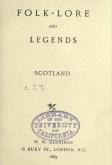The Dracae
Scottish Folktale
These are a sort of water-spirits who inveigle women and children into the recesses which they inhabit, beneath lakes and rivers, by floating past them, on the surface of the water, in the shape of gold rings or cups. The women thus seized are employed as nurses, and after seven years are permitted to revisit earth. Gervase mentions one woman in particular who had been allured by observing a wooden dish, or cup, float by her, while she was washing clothes in the river. Being seized as soon as she reached the depths, she was conducted into one of the subterranean recesses, which she described as very magnificent, and employed as nurse to one of the brood of the hag who had allured her. During her residence in this capacity, having accidentally touched one of her eyes with an ointment of serpent’s grease, she perceived, at her return to the world, that she had acquired the faculty of seeing the Dracæ, when they intermingle themselves with men. Of this power she was, however, deprived by the touch of her ghostly mistress, whom she had one day incautiously addressed. It is a curious fact that this story, in almost all its parts, is current in both the Highlands and Lowlands of Scotland, with no other variation than the substitution of Fairies for Dracæ, and the cavern of a hill for that of a river. Indeed many of the vulgar account it extremely dangerous to touch anything which they may happen to find without saining (blessing) it, the snares of the enemy being notorious and well-attested. A pool-woman of Teviotdale having been fortunate enough, as she thought herself, to find a wooden beetle, at the very time when she needed such an implement, seized it without pronouncing a proper blessing, and, carrying it home, laid it above her bed to be ready for employment in the morning. At midnight the window of her cottage opened, and a loud voice was heard calling up some one within by a strange and uncouth name. The terrified cottager ejaculated a prayer, which, we may suppose, ensured her personal safety; while the enchanted implement of housewifery, tumbling from the bedstead, departed by the window with no small noise and precipitation. In a humorous fugitive tract, Dr. Johnson has been introduced as disputing the authenticity of an apparition, merely because the spirit assumed the shape of a teapot and a shoulder of mutton. No doubt, a case so much in point as that we have now quoted would have removed his incredulity.
Folk-Lore and Legends: Scotland

Notes: Contains 33 Scottish folktales.
Author: Charles John Tibbitts
Published: 1889
Publisher: W. W. Gibbings, London